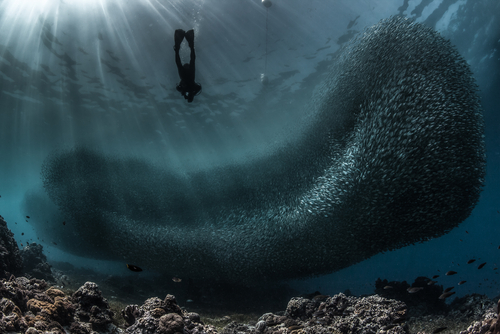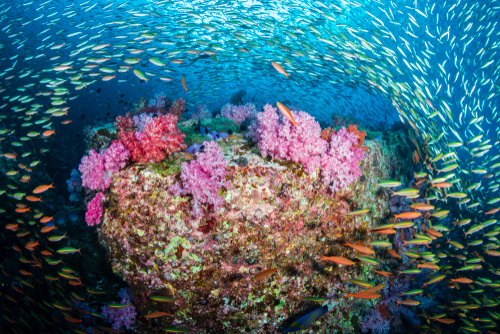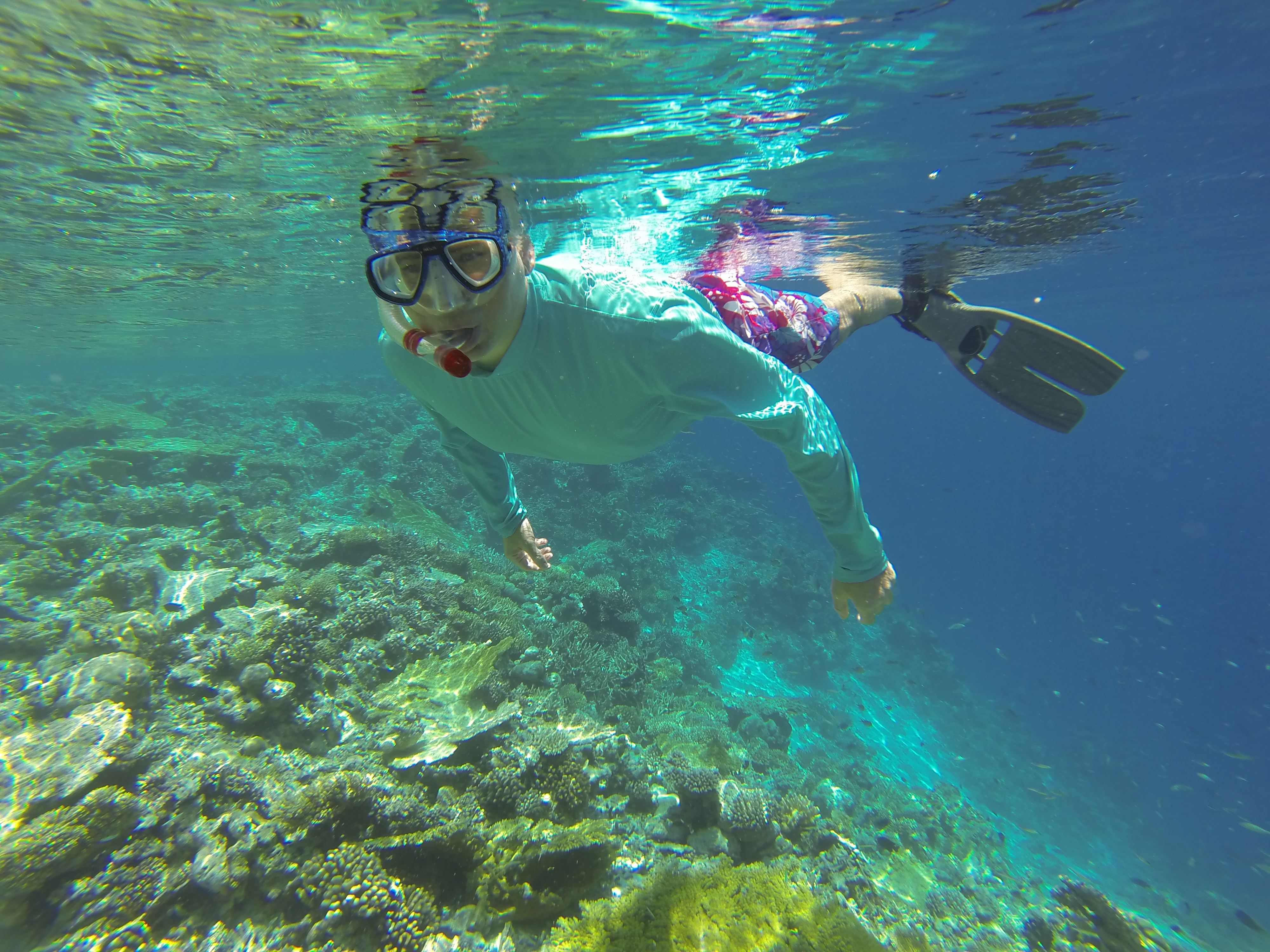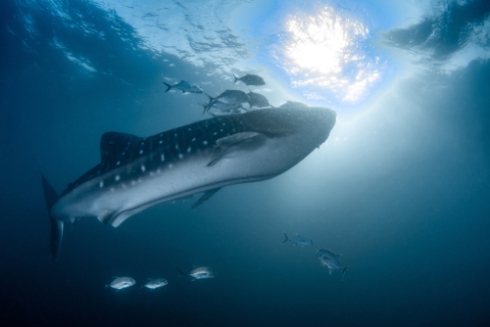‘‘There were walls of fish, so many you could hardly see the corals”

Callum Roberts tells Tom Ireland how a network of protected areas of ocean can not only save marine biodiversity but help sustain the fishing industry in the long term
The Biologist 66(3) p12-15
Professor Callum Roberts is an oceanographer and conservationist at the University of York. After beginning his career studying the biodiversity and behaviour of coral reef fish, Roberts became increasingly interested in trying to quantify the benefits of marine protected areas (MPAs).
In his book The Unnatural History of the Sea, Roberts draws on accounts of early explorers, merchants and pirates to build a picture of ocean ecosystems before intensive fishing, when waters teemed with what now seems like an extraordinary abundance of life. Roberts has also worked as an adviser to the BBC series Blue Planet and helped create a global database of coral reef fish biodiversity.
Since the 1990s his work has helped demonstrate dramatic recoveries in marine ecosystems where fishing has been prohibited. These protected habitats can quickly become so productive that they help replenish fish stocks in regions outside the protected areas. Roberts is now leading efforts to get 30% of the world’s oceans protected from fishing by 2030.
You’ve just returned from working in the field. Where is the field for you at the moment?
In the Maldives. I was teaching a field course on coral reef ecology and conservation, and we also have a field project run by the Blue Marine Foundation on an atoll in the Maldives called Laamu. I work with many environmental groups these days, helping them translate science into conservation action.
What does a good marine protected area look like?
When I first started studying reefs in Belize I went to a place called the Hol Chan Marine Reserve. I’d been diving around the world for 10 years by this time, so I had a good bit of experience, but I was blown away by the sheer abundance of fish.
There were walls of them rising up the side of the reef, so many you could hardly see the corals. And these fish were big and highly desirable to the fishing industry: big groupers, barracudas as long as an arm, snappers and grunts. Outside the reserve, where there was fishing, there was a fraction of the abundance and fewer of the big fish around. That taught me, first of all, that fishing has a huge impact on marine ecosystems. In the early 1990s we were only just beginning to really understand that.
The second thing it taught me was that we have an incredibly powerful tool to restore that lost abundance. The lessons of that research have now been repeated a thousand times, across almost every sea, from people studying protected area after protected area.
 Oceanic insecurity
Oceanic insecurityIt is believed that there has been a net loss of 70% of larger marine life since the onset of industrial hunting and fishing. Areas of habitats such as kelp forests, mangroves, coral reefs and oyster reefs have been reduced by between 10% and 50%. Without oceanic marine life capturing and storing carbon, it is thought the atmosphere would contain up to 50% more CO₂.
You worked on the new ‘30x30’ report with the University of York, the University of Oxford and Greenpeace, which sets out a blueprint for protecting 30% of the ocean
by 2030. Tell us a bit about your main ambitions for this work.
One of the big things we’re hoping for is a legal instrument that allows the creation of a network of MPAs on the high seas. International waters are managed by regional fisheries management organisations that are, on the whole, extraordinarily ineffective.
The high seas are essentially a lawless place.
What we’re trying to do is move towards a mechanism that will establish this network across all of the world’s international waters through the United Nations.
How do you determine where protected areas should go?
I first worked with Greenpeace on its ‘Roadmap to Recovery’, released in 2006, which tried to challenge the idea that we didn’t know enough about the high seas to protect them. We compiled all the evidence we could find about the structure of high-seas ecosystems and the threats they were facing, and using decision-support software drew up a network of protected areas.
Greenpeace approached us again recently to revisit the roadmap using the increased data set that now exists for international waters – satellite information on currents, surface temperatures, where people are fishing, plus more sampling – there’s a huge amount of data compared with the mid-2000s.
So we’re having another go and doing it in much more depth. In the original roadmaps we split the ocean into large planning units of 5° latitude by 5° longitude. This time we’ve used 25,000 100km x 100km cells and 458 different conservation, biogeographical and economic features to look at where this network of protected areas could go.
How did you come up with the target of 30%?
The UN Convention on Biodiversity (CBD) originally set a target of protecting 10% of the world’s oceans by 2012, which was missed and rolled over to 2020. This was always really a political target that was not too big to put countries off but not too small that it seemed trivial.
We published a paper in 2003 looking at how much of the sea you need to protect in order to optimise a number of goals that MPAs are established to deliver, such as biodiversity protection, ecological connectivity – to make sure they are working as a network not isolated entities – and the support of fisheries in surrounding areas.
We found it wasn’t 10%, it was 20–30%. When we revisited that in 2016 with a much bigger volume of literature – by now there were more than 150 studies on this question – the number was revised upwards to 37%. That work underpinned a motion at the World Conservation Congress that we should aim to protect at least 30% by 2030, which was the first enshrining of that target.
The [15th] Conference of the Parties to the CBD will be held in Kunming, China, in 2020 and we have been feeding into that process to ensure there is a solid basis for 30% as a new target by 2030.
I think now there is an exciting consensus building around this level of protection. It’s good to see we are moving from a political target to one based on science.
 Callum Roberts diving in the maldives
Callum Roberts diving in the maldives Presumably the definition of ‘protected’ varies in different locations and economies?
Yes. The benefits are proportional to the level of protection given.
Highly or fully protected marine reserves – areas that exclude all fishing or nearly all fishing – produce fantastic benefits, and quickly. But light protection produces minimal benefits – we see little in the way of recovery. These constitute, unfortunately, a large fraction of MPAs around at the moment, including those at home in the UK.
We are establishing world-class, gold-standard MPAs in places such as the Pitcairn Islands [in the Pacific] and the Chagos Archipelago [in the Indian Ocean], but in our home waters we are creating these paper parks that provide almost no protection.
A study in Science at the end of last year showed there was more trawling and less in the way of sharks and rays inside [lightly protected MPAs] than outside, so we have the worst possible of worlds – some are just a complete sham – but it can be rescued by giving them much higher levels of protection.
That means excluding things like bottom trawls or scallop dredges, and ideally prohibiting all forms of fishing. We need to provide high levels of protection to whole ecosystems, not just little bits of seabed without protecting the overlying water column.
Is there a minimum size an MPA can be and still produce these wider positive ecosystem effects?
I once published a study called ‘How small can a marine reserve be and still be effective?’ The first reprint request I got was from a politician in western Australia! I thought: “I know what you’re up to…”
We looked at a protected area in the Caribbean just 2.6 hectares in size. It still had three times as many fish in it as reefs just on the other side of the boundary. So here was an example that really small places can work.
Of course, ecological science tells us there are many reasons to make things larger – the bigger it is the more plants and animals it will include; and bigger population sizes mean more stability against shocks and the risk of extinction, and from threats from the boundary edge.
For all those reasons you want the area to be pretty large, but if they become too large they suck up all the space that people use and create many losers in terms of communities that have no access to resources.
Where that balance lies depends on how populous the coast is and how intense the uses of the environment are. In the UK network, based on science we did for the Joint Nature Conservation Committee, we said they should be 10–20km² at their minimum dimension to ensure they adequately protect the wildlife inside, and they should be no further than 40–80km apart to enable connectivity to take place.
Is their size less restricted on the high seas?
On the high seas you’re talking about a whole different game in terms of dimensions.
People travel a long way to get to areas of the high seas to fish, so if you create a large protected area in one spot, they can just adjust their course slightly and go somewhere else without it costing any more to get there. You can create much bigger protected areas. Which is right because many of the species that occupy the high seas are long-distance travellers. Tunas, for example, will bridge entire ocean basins, from Japan to California, in the course of their migrations.
How has the fishing industry responded to your work? Does the industry recognise that protected areas could help boost fish stocks in the long term or do they just oppose any restriction on where they can fish?
Parts of the industry like the idea, other parts don’t. In areas where MPAs have been established – whether or not people in the fishing industry wanted them – we see that people become supportive of them because they can see how they are beginning to improve fish stocks.
Unfortunately, the lobby level of the fishing industry in the UK has not embraced the idea.
There is also an unhelpful debate out there, where a bunch of contrarian industry-funded scientists are sowing disinformation about protected areas. Certain people obviously prefer the views of those contrarian scientists – it’s completely analogous to climate change.
That said, the industry will be better off with marine protected areas. Over time they need them in order to safeguard the high-quality habitats that they depend on and to ensure fish stocks survive and thrive in an era of rapid global change. That’s the other thing about creating these large-scale networks – it’s a way of helping the ecosystems and environment cope as conditions worsen as a result of climate change.
You grew up in Scotland – did your love of marine biology develop there or was it trips to beautiful warmer seas that got you hooked?
Growing up in Wick, on the far-flung northeast coast of Scotland, gave me a deep love of the sea.
Teenagers love to get away from their parents and siblings, and I did so by taking long hikes along the cliffs, losing myself in the brisk, salt wind and the clamour of seabirds. It was diving in the Red Sea as a 20-year-old that solidified this passion into a wish to become a marine scientist.
You must have travelled to many incredibly beautiful oceans and coasts around the world – which is your favourite and why?
I’m always reluctant to name a favourite place. The experience is always unique to a time as well as a place. To add further difficulty, how do you compare an exceptional shark dive with a beautiful coral garden or a rich kelp forest?
There are standouts, though. I just came back from diving at the Six Senses resort in the Maldives where I had close encounters with a huge hammerhead shark and whale shark on the same dive. That set my pulse racing.
 Nautical Networks
Nautical Networks Marine protected areas (MPAs) have been shown to help populations recover to between five and 10 times the abundance found outside the protected area, with reproduction rates between 10 and 100 times higher. MPAs are ideally established in networks to ensure ecological connectivity between recovering areas. Productive networks of protected areas can support fisheries by helping build up fish stocks that then ‘spill over’ into surrounding areas. Protected ecosystems are also more resilient to threats from climate change, ocean acidification and plastic pollution. The position of MPAs proposed in the 30x30 report are based on biological, oceanographic, biogeographical and economic data, such as the distributions of sharks, whales, breeding grounds, trenches, hydrothermal vents, oceanic fronts, commercial fishing pressure and mining claims.
I’m interested in your book in which you collated information from old seafarers’ and pirates’ accounts of marine life. What sort of usable information were you able to get from these sources?
Pirates were great observers of marine life. They couldn’t shop at the local market for provisions or get enough from sacking towns, so they fished and hunted.
Moreover, many pirates were writers too and their books were hugely popular. Their accounts reveal the historic locations and size of seal rookeries and manatee aggregations, and describe fish catches that would astonish today.
From these stories, researchers have estimated the historic size of the now extinct Caribbean monk seal population, and, from that, how many fish there would have had to be on the reefs to support them. The answer is many times more fish than there are now.
The UK leaving the EU will mean withdrawing from the Common Fisheries Policy. Are there any potential positives for marine life from Brexit?
The EU is a cumbersome bureaucracy when it comes to marine fisheries and conservation. It has been hard to make progress to end overfishing and to establish meaningful protected areas.
If there is a plus to leaving the EU, it is that we will have greater control over our waters than before. However, more fish and healthier habitats will only come about from better management. There is growing political will, but it will require sustained leadership over years to get to where we need to be.
You wrote a few years ago of an EU plan to fish for plastic – has that ever been developed? Could it work?
There is a scheme, supported by the EU, to reward fishers for catching plastic and returning it to recycling facilities on land, rather than chucking it back into the sea. It’s a small but important part of the response needed to tackle a fast-growing problem. Professor Callum Roberts is a marine conservation biologist at the University of York’s Department of Environment and Geography. His research focuses on humans’ impact on marine ecosystems and how best to protect marine life. He has developed global maps of the biodiversity distribution of reef fishes with the Coral Reef Fish Specialist Group of the World Conservation Union, served on several international panels on marine protected areas and was awarded a Pew Fellowship in Marine Conservation in 2000 to tackle obstacles to implementing marine reserves.
He was recently awarded the Grand Prix des Science de la Mer by the Société de Géographie in France for contributions to the science of ocean conservation and its communication to a broad audience.
1) 30×30: A Blueprint for Ocean Protection


